

You can have an “equations sheet”
One side of ordinary 8.5” x 11” paper

1 Light from a flower’s petal inside a glass (n = 1.50) paperweight
strikes the glass / air (n = 1.00) interface at an angle of 27o.
What is the angle of refraction for this light as it leaves the glass and goes
into the air?

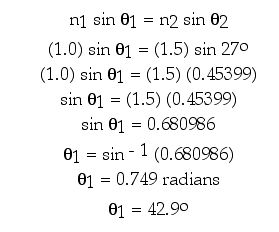
2. Consider looking at yourself in a shaving
mirror or a make-up mirror. The mirror has a focal length of 1.0 m and your
eye is 0.30 m away from the mirror.
a) Make a clear ray diagram showing where the image is located.
b) Calculate where the image is located.
Characterize or describe the image: Is the image
c) real or virtual?
d) enlarged or reduced?
e) right side up or upside down?
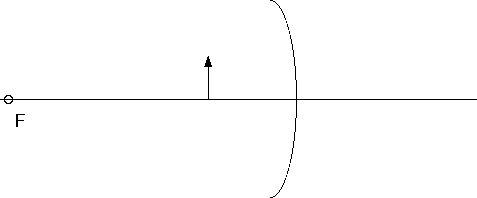
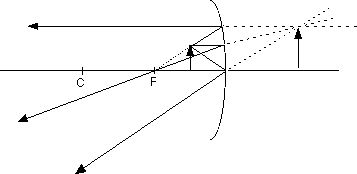
Start with the “image equation”,
1/f = 1/di
+ 1/do
1/di = 1/f - 1/do
1/di = 1/1.0 m - 1/0.30
m
1/di = (1 - 3.333)(1/m)
1/di = - 2.333 (1/m)
di = - 0.429 m
From either the ray diagram or our sign conventions, this tells
us the image is virtual.
From the ray diagram we can see that the image is right side up.
How big is it?
M = hi/ho = - di/do
M = - di/do
M = - ( - 0.429 m)/(0.30 m)
M = + 1.43
M > 0 means the image is right-side-up.
|M| > 1 means the image is enlarged
To summarize, then, the image is virtual, right-side-up, and larger.

3. Consider a converging lens with a focal length of
f = 20 cm. An object is placed at do = 60 cm as shown in the sketch
above.
a) Make a clear ray diagram showing where the image is located.
b) Calculate where the image is located.
Characterize or describe the image: Is the image
c) real or virtual?
d) enlarged or reduced?
e) right side up or upside down?
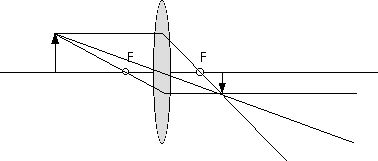
From the ray diagram, we can see that the image is real,
smaller, and upside-down.
We can also find that from calculations:
Start with the “image equation”,
1/f = 1/di
+ 1/do
1/di = 1/f - 1/do
1/di = 1/20 cm - 1/60
cm
1/di = (0.050 - 0.0167)(1/cm)
1/di = (0.0333)(1/cm)
di = 30 cm
Now our sign conventions become important.
di > 0 means the image is real.
M = hi/ho = - di/do
M = - di/do
M = - ( 30 cm)/(60 cm)
M = - 0.5
M < 0 means the image is inverted or upside down.
|M| < 1
means the image is smaller.
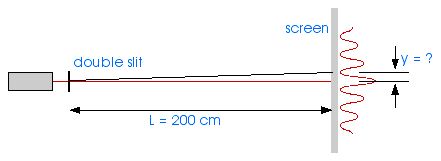
4. A HeNe laser, like the one we used in class, has a wavelength of 634 nm.
That light is shined on a double slit with a separation distance of 0.3 mm
and an interference pattern is produced on a screen (or the wall!) that is 2.0
m away.
What is the distance between the bright, central maximum and the first dark
minimum on either side of it?
The dark minimum or destructive interference minimum occurs for

For the first minimum, m = 0 or
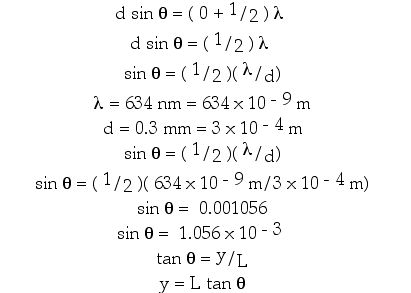
For such small angles,
tan 5. A patient's eye can focus only on objects beyond 100 cm. [Added in class, on the board: You want to prescribe contact lenses so this
patient can hold a book at a comfortable or convenient distance of 25 cm and
be able to see it clearly.] 1/f = 1/di + 1/do Concept Questions: a) Consider two parallel polarizing filters, A and B,
as shown below. Another polarizing filter, C, is placed between them. As this
third polarizing filter C is rotated through a full 360°, how many times
does the beam of light cycle from dark to bright?
= sin
= 1.056 x 10 - 3
y = (2.0 m) (1.056 x 10 - 3 )
y = 2.1133 x 10 - 3 m
y = 2.1 mm
What word characterizes this type of vision problem?
What is the focal length of the contact lens needed to correct this problem?
(added, on the board) We would like to enable this patient to conveniently
read a Physics textbook held at a comfortable distance of 25 cm.
This patient is far-sighted.
We would like to enable this patient to conveniently read a Physics textbook
held at a comfortable distance of 25 cm.
This means do = 25 cm. The eye needs di = - 100 cm (the
image distance is negative because it is a virtual image). Now we are
ready to use the image equation,
1/f = (1/25 cm) + (1/(
- 100 cm))
1/f = (0.04 - 0.01)(1/cm)
1/f = 0.03 (1/cm)
f = (1/0.03) cm
f = 33.3 cm
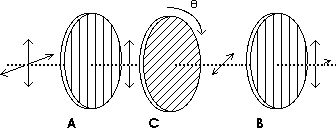
Whenever filter C is perpendicular to filter A or
filter B, there will be no light. Since A and B
are parallel, this happens only twice as C rotates 360o.
Notice that this is very different from the behavior
of colored filters. If we had a very good red
filter at position A and a very good blue
filter at position B, no light would pass throug. Placing a very good green
filter at C would NOT allow any light to pass through!
b) Consider two perpendicular polarizing filters, A and
B, as shown below. Another polarizing filter, C, is placed between them. As
this third polarizing filter C is rotated through a full 360°, how many
times does the beam of light cycle from dark to bright?
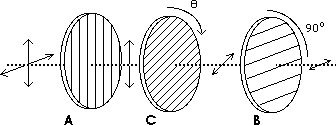
Whenever filter C is perpendicular to filter A or
filter B, there will be no light. Since A and B
are perpendicular, this happens four times as C rotates
360o.
As with Concept Question a) above, notice again that this is very different
from the behavior of colored filters. If we had a very good red
filter at position A and a very good blue
filter at position B, no light would pass throug. Placing a very good green
filter at C would NOT allow any light to pass through!
c) Distinguish between a virtual image and a real image
Light passes through a “real image” and, therefore, the image can
be projected on a card or a screen -- or your hand. Light appears to come from
a “virtual image” but does not actually pass through the “virtual
image”. Therefore, a virtual image can not be projected.
d) What evidence can you cite that light is a wave?
The interference pattern of Young’s Double Slit experiment is a classic
example. The interference patterns from a single slit or a diffraction grating
are also good evidence.
There is nothing analogous to polarization for a stream of particles so the
polarization of light is further evidence that light is a wave. Since light
can be polarized it must be a transverse wave.
e) What advantages does a reflector telescope have over a refractor
telescope? That is, what advantages does mirror telescope have over a lens telescope?
A reflecting telescope does not have “chromatic abberation”.
Due to dispersion, any lens -- like the lenses in a lens telescope or a refractor
telescope -- will not focus light of different colors at exactly the same location.
This does not happen with reflection.